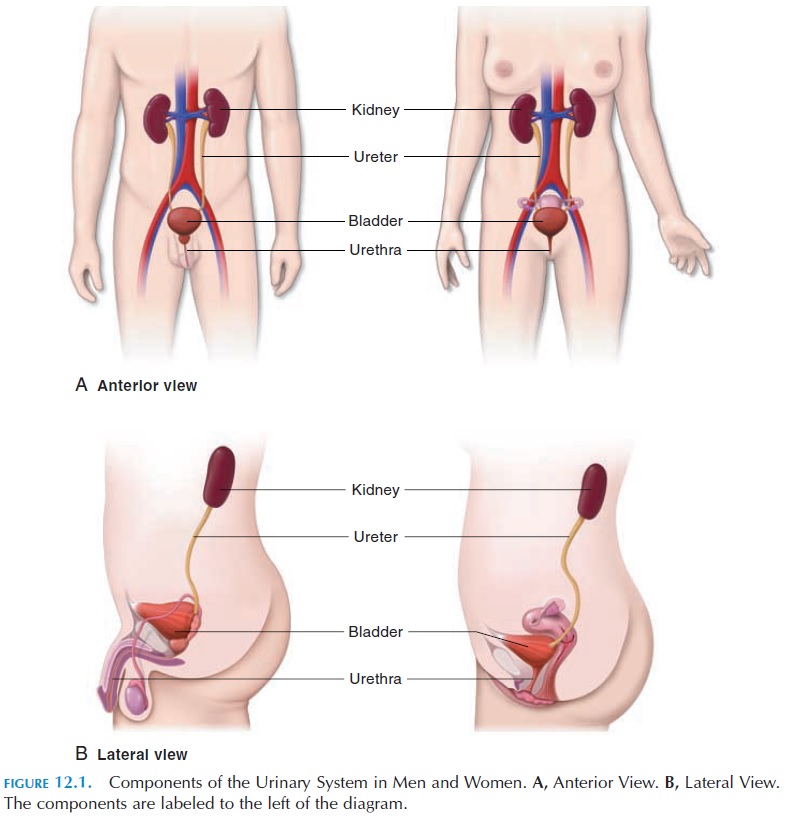Chapter: The Massage Connection ANATOMY AND PHYSIOLOGY : Urinary System
Transportation and Elimination of Urine
Transportation and Elimination of Urine
THE URETER
Ureters are muscular tubes, about 30 cm (11.8 in) long, that extend from the kidney to the posterior aspect of the urinary bladder. The lumen is lined by transitional epithelium. The walls contain smooth muscle, arranged in spiral, longitudinal, and circular bundles. The ureters convey urine from the kidneys to the bladder. The ureters extend medially and infe-riorly from the pelvis of the kidney and pass over the psoas muscles. They lie behind the peritoneum and are attached to the posterior abdominal wall by con-nective tissue. They then enter the bladder obliquely and open into the bladder by means of slitlike open-ings—ureteral openings. When the bladder con-tracts, these openings are closed and backflow of urine (reflux) is prevented.
Beginning at the pelvis, the smooth muscle in the wall of the ureters undergoes rhythmic, wavelike con-tractions every few seconds, which helps force the urine toward the bladder.
THE URINARY BLADDER
The function of the bladder is to temporarily store urine. It is a hollow muscular organ, which is held in place by connective tissue that attaches it to the walls of the pelvic cavity. Superiorly, it is covered by peri-toneum; posteriorly, the bladder is related to the rec-tum in males and the uterus and upper part of the vagina in females (Figure 12.1). When the bladder is empty, the uterus rests on its superior surface. The bladder is held in position by ligaments that run from its base to the pubis anteriorly and to the rectum and sacrum posteriorly. A fibrous band runs from its su-perior surface to the anterior abdominal wall and umbilicus. The peritoneum, which covers part of the bladder, also provides some support.

When not distended by urine, the inner lining of the bladder is thrown into folds, except in a triangular re-gion in its posterior part (the trigone). The three points of the triangle are made up of the two superior orifices of the ureter and the urethral opening inferi-orly. The bladder’s inner lining is transitional epithe-lium, which allows for easy distension and contraction of the bladder. The wall of the bladder is largely smooth muscle—the detrusor muscle—arranged in three layers; the inner and outer longitudinal and mid-dle circular. The urethra opens out of the bladder at its most inferior point, the neck. The region of the blad-der surrounding the urethral opening consists of cir-cular smooth muscle, the internal urethral sphinc-ter, or sphincter vesicae. The detrusor muscle andthe sphincter are controlled by autonomic nerves. The sympathetic nerves relax the detrusor and close the sphincter, and the parasympathetic nerves contract the detrusor and relax the sphincter (the opposite of the sympathetic nerves).
THE URETHRA
The urethra extends from the neck of the bladder to the external urethral opening, or external urethralmeatus. The male urethra is about 18–20 cm (7.1–7.9in) long as compared with the female urethra, which is only about 3–5 cm (1.2–2 in) long. The shortness of the urethra and its close proximity to the anus, vagina, and exterior and constant irritation to the tissue as a result of tampons and sexual activity, etc., make a woman more prone to urinary tract infections.
The male urethra extends from the neck of the bladder through the center of the prostate gland (prostatic urethra) and penetrates through the mus-cular floor of the pelvis (membranous urethra). Fi- nally, it passes through the penis (penile, or spon-giosa urethra) and opens to the exterior. The urethrain men is a common passage for urine and semen.
In both men and women, a band of circular skele-tal muscle surrounds the urethra as it passes through the pelvic floor. This is the external urethral sphinc-ter, which is under voluntary control and is relaxedvoluntarily when urine is expelled.
Related Topics